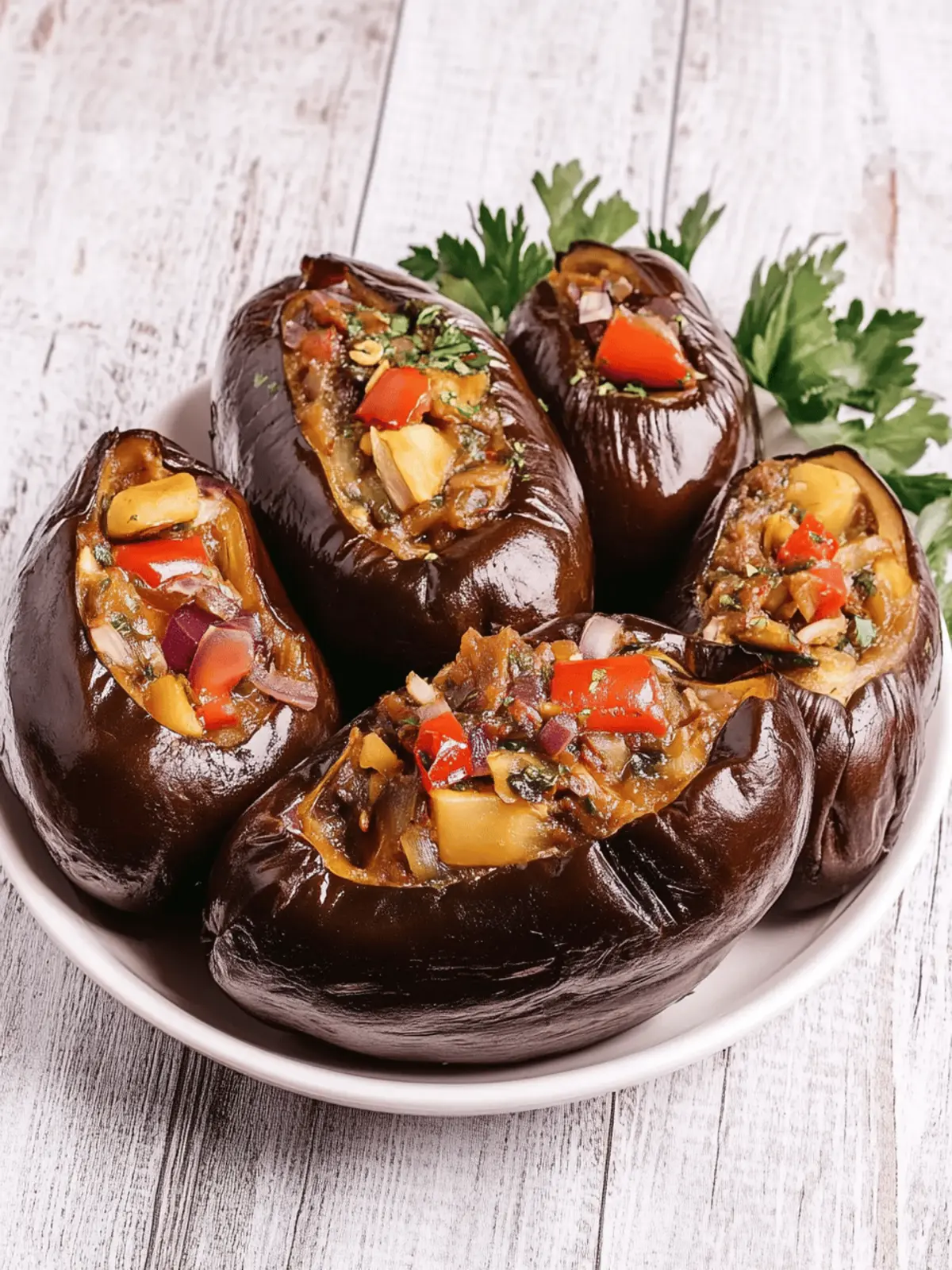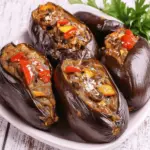There’s a certain enchantment in transforming simple ingredients into a delightful culinary treasure, and Lebanese Makdous (Stuffed Pickled Eggplant) is the perfect embodiment of this. After spending an afternoon at a local farmers’ market, I discovered the tiniest baby eggplants—charming little gems just begging to be brought to life. The idea of pickling them with a flavorful walnut filling instantly transported me to the lively streets of Lebanon, where every mezze plate tells a story.
As I began the process of brining and stuffing these beauties, the aroma of garlic mingled with the nuttiness of walnuts and the subtle heat of red pepper flakes filled my kitchen, making my mouth water in anticipation. What I love most about Makdous is its perfect balance of tangy and savory flavors, plus its flexibility. These little bites are not only a showstopper on any dinner table but they also give you a chance to prepare something special ahead of time.
If you’re looking to break free from the fast-food rut and elevate your meals to a homemade feast that’s bursting with flavor, this recipe is a must-try. So, let’s dive into the art of making Lebanese Makdous and bring some Mediterranean magic to your kitchen!
Why will you love Lebanese Makdous?
Flavor Explosion: Each bite bursts with a harmonious blend of garlic, walnuts, and spices that elevate simple eggplants into a savory delight.
Make-Ahead Magic: Perfect for meal prep, these delightful bites are best enjoyed after pickling, allowing you to plan ahead for gatherings.
Versatile Serving: Serve them as part of a mezze platter, on sandwiches, or simply as a unique appetizer that impresses guests.
Healthy and Wholesome: Packed with nutrients, these stuffed eggplants are a guilt-free indulgence, moving you away from fast food and towards fresh ingredients.
Culinary Adventure: Try your hand at an authentic recipe that brings Middle Eastern flavors to your home, expanding your cooking repertoire in a fun and delicious way!
Lebanese Makdous Ingredients
For the Eggplants
• Baby eggplants – 8 small ones, about 8-10 cm long, the star of this delightful dish!
• Salt – 2 tbsp for brining, essential for extracting moisture and enhancing flavor.
For the Filling
• Walnuts – 1 1/2 cups finely chopped, adding a rich and nutty flavor that pairs beautifully with the eggplants.
• Garlic – 4 cloves minced, a must for infusing that tasty savory kick!
• Red pepper flakes – 1 tsp, to ignite a slight heat that balances the overall taste.
• Ground cumin – 1/2 tsp optional, for a warm earthy flavor that complements the spices.
• Ground coriander – 1/2 tsp optional, adds a fresh citrusy note to the filling.
• Red bell pepper – 1/4 cup finely chopped, contributing crunch and sweetness to the stuffing.
• Salt – Adjust to taste, ensuring the right seasoning brings all flavors together.
For Preserving
• Olive oil – 1/2 cup plus more for preserving, essential for maintaining freshness and enhancing flavor while pickling.
How to Make Lebanese Makdous
-
Boil Bring a large pot of water to a boil. Trim the stems from the baby eggplants, but keep them whole. Blanch the eggplants in boiling water for 5-7 minutes until they’re slightly softened, then drain and let cool.
-
Slice and Salt Once the eggplants are cool enough to handle, carefully make a slit lengthwise in each one, stopping about 3/4 down. Sprinkle salt inside the slits and all over the eggplants. Place them in a colander, cover with a plate, and add some weight to help extract moisture. Let them drain for 24 hours.
-
Mix Filling In a medium bowl, combine the finely chopped walnuts, minced garlic, red pepper flakes, and finely chopped red bell pepper. If you’re using cumin and coriander, add them now. Mix in 2 tablespoons of olive oil to help bind the mixture and season with salt to taste.
-
Stuff Rinse the eggplants under water to remove excess salt and pat them dry with paper towels. Gently open each eggplant and stuff with the walnut mixture, packing it in firmly.
-
Jar In a sterilized jar, layer the stuffed eggplants, pressing them down gently to pack snugly. Pour enough olive oil into the jar to cover the eggplants completely.
-
Seal and Store Seal the jar tightly and place it in a cool, dark place. Allow the makdous to pickle for at least 5-7 days; for the richest flavor, let them cure for two weeks.
-
Serve When ready, remove the makdous from the jar. Drizzle with extra olive oil if desired and serve them as part of a mezze spread.
Optional: Pair with fresh pita bread for an extra touch of delight.
Exact quantities are listed in the recipe card below.
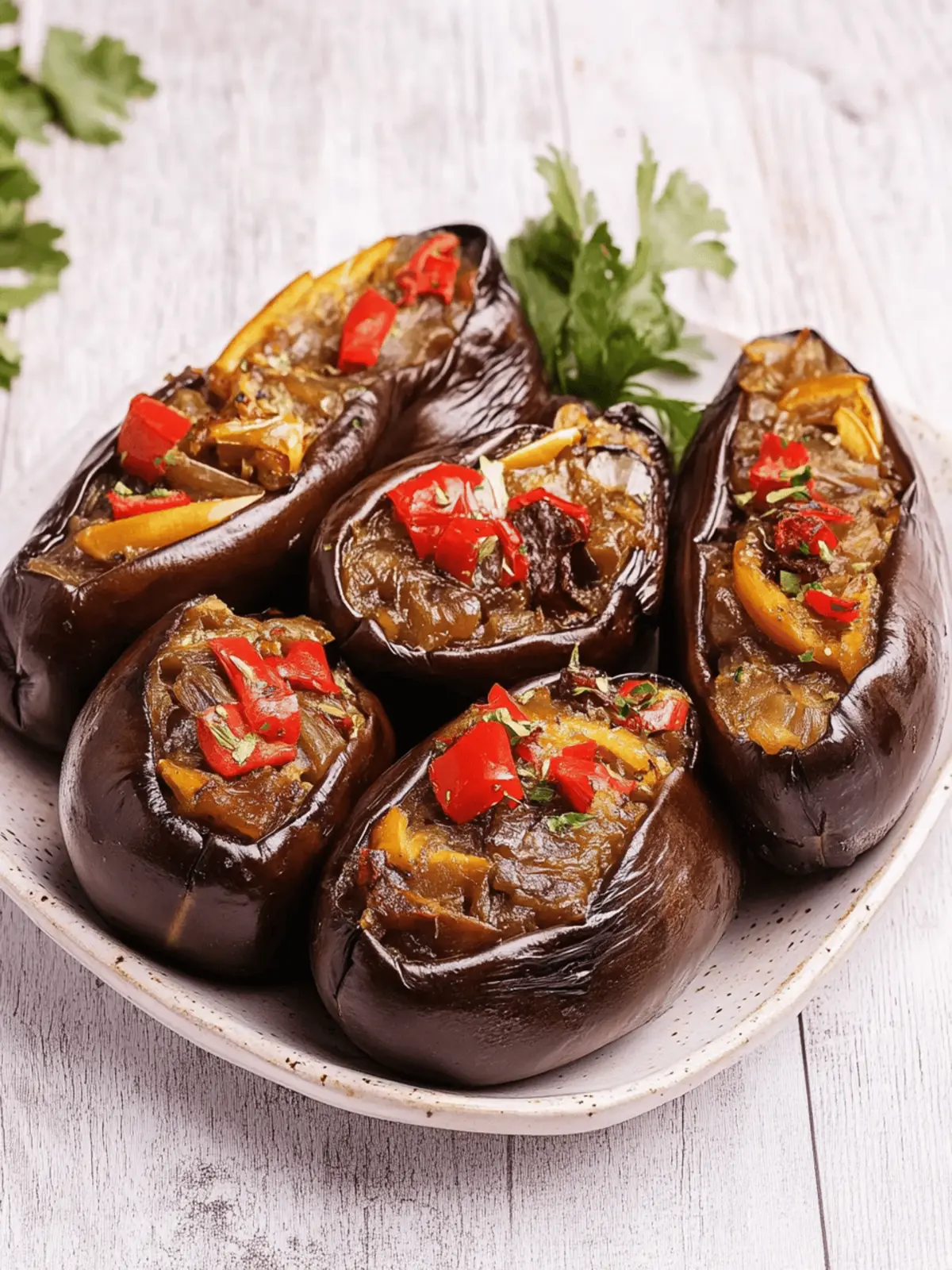
Make Ahead Options
These Lebanese Makdous (Stuffed Pickled Eggplant) are fantastic for meal prep, allowing you to savor their rich flavors without spending all day in the kitchen. You can prepare the stuffed eggplants by blanching and salting them up to 24 hours in advance, letting them drain and soften to perfection. The filling can also be mixed a day ahead, ensuring that the flavors meld beautifully. Once stuffed, simply layer the eggplants in a sterilized jar, cover them with olive oil, and seal tightly. For optimal taste, let them pickle in a cool, dark place for at least 5-7 days—the longer, the better for that authentic flavor! Just remember to keep them submerged in oil to maintain their quality until you’re ready to serve.
Expert Tips for Lebanese Makdous
-
Choose the Right Eggplants: Opt for small, firm baby eggplants; they will hold their shape better and offer a perfect balance of flavor when pickled.
-
Salt Properly: Don’t rush the salting process! Ensuring the eggplants are adequately salted helps draw out moisture, enhances flavor, and prevents sogginess.
-
Filling Consistency: Make sure your walnut mixture is well-bound but not too wet. This prevents the filling from oozing out while pickling; adjust olive oil as needed.
-
Sterilize Your Jar: Clean and sterilize your jars before use to prevent spoilage. The right storage will ensure your Lebanese makdous stays fresh and delicious for weeks!
-
Patience is Key: Allow your makdous to pickle for the full time for maximum flavor. While you may be eager to taste them, the maturity of flavors makes it worth the wait!
-
Additional Olive Oil: When serving, a drizzle of extra olive oil not only enhances flavor but also gives a lovely presentation. Enjoy your delicious Lebanese Makdous!
Lebanese Makdous Variations & Substitutions
Feel free to explore and customize your Lebanese Makdous to match your taste and dietary preferences!
- Nut-Free: Substitute walnuts with sunflower seeds or sunflower seed butter for a nut-free version that’s equally delicious.
- Spicy Twist: Add diced jalapeños or switch to a hot chili oil for a fiery kick if you love a bit of heat in your dishes.
- Herbaceous Flavor: Incorporate fresh herbs like parsley or cilantro into the walnut filling to elevate freshness and add vibrant notes.
- Roasted Peppers: Replace raw red bell pepper with roasted red peppers for a sweeter, smoky flavor that complements the eggplant beautifully.
- Vegan Substitute: Ensure the olive oil is from a reliable vegan source for a dish that’s completely plant-based and cruelty-free.
- Creamy Addition: Mix in a spoonful of tahini with the walnut filling for a creamier texture that adds depth and richness.
- Add-ons: Toss in some capers or olives to the filling for a briny touch that pairs wonderfully with the eggplants.
- Citrus Zest: A pinch of lemon or orange zest can brighten the flavors, adding a pop of citrus that’s refreshing against the savory filling.
With these variations, you can make Lebanese Makdous your own, satisfying both your cravings and culinary adventures!
What to Serve with Lebanese Makdous?
Elevate your dining experience by pairing these delightful stuffed eggplants with complementary dishes that enhance their flavors.
-
Fresh Pita Bread: Perfect for scooping up the makdous, this warm, fluffy bread adds a delightful texture to each bite. The pillowy softness creates a comforting contrast to the tangy filling.
-
Mediterranean Quinoa Salad: A refreshing blend of quinoa, cucumber, and herbs, this salad brings a burst of freshness and crunch that perfectly balances the richness of the makdous.
-
Hummus Platter: Creamy and smooth, hummus provides a delicious dipping option, allowing you to enjoy the makdous with extra layers of flavor. Pair with olives for a delightful Mediterranean experience.
-
Stuffed Grape Leaves: The fragrant herbs and spices in these savory bites create an irresistible flavor combo with the makdous. Both offer a delightful taste of tradition that’s perfect for sharing.
-
Grilled Meat Skewers: Tender and smoky, these skewers can lend a lovely savory dimension to your meal, playing off the eggplants’ bold flavors while adding substance to your spread.
-
Mint Tea: A fragrant, soothing drink that complements the spices in the makdous beautifully. This sweet and minty beverage offers a refreshing contrast that’s sure to cleanse your palate between bites.
-
Baklava: For dessert, serve these sweet, flaky pastries filled with nuts and honey. The richness of baklava offsets the savory notes of the makdous and creates a satisfying finish to your meal.
-
Roasted Vegetable Medley: A colorful array of seasoned vegetables adds earthy flavors that harmonize with the deep richness of the stuffed eggplants, enhancing your dining experience.
-
Tzatziki Sauce: Creamy and cool, this yogurt dip can add a refreshing element to your plate, offering a cooling contrast to the spiced filling of the makdous.
-
Zaatar-Spiced Yogurt: A slightly tangy dip that adds a herby brightness to every bite, enhancing your makdous and enriching the overall mezze experience.
How to Store and Freeze Lebanese Makdous
Fridge: Store opened jars of makdous in the refrigerator for up to 1 month. Ensure they are fully submerged in olive oil to maintain freshness and flavor.
Freezer: If you’d like to store makdous for longer, freeze individual portions in airtight containers for up to 3 months. Thaw in the fridge before serving.
Sealing: Always seal jars tightly before storing. This prevents air exposure and keeps your delicious Lebanese makdous as fresh as possible.
Reheating: While these pickled eggplants are best enjoyed cold or at room temperature, if you prefer, gently warm them in a pan over low heat, drizzling with a bit more olive oil for added richness.
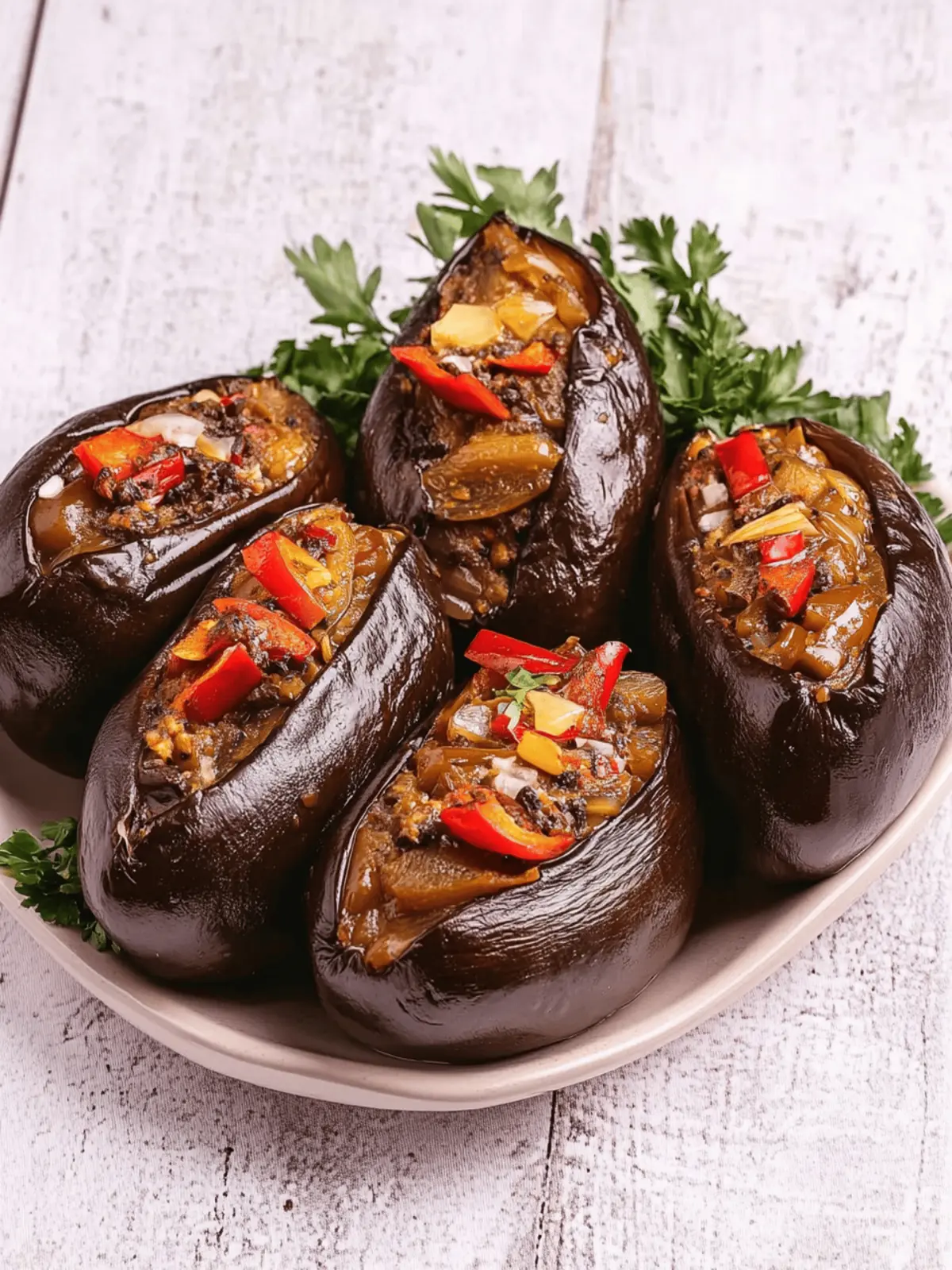
Lebanese Makdous Recipe FAQs
What is the best way to select eggplants for this recipe?
Absolutely! When choosing eggplants, look for small, firm baby eggplants that are glossy and free from blemishes or dark spots. They should feel weighty for their size, which indicates freshness. Aim for those that are about 8-10 cm long, as they are the perfect size for stuffing!
How long can I store Lebanese Makdous in the fridge?
Once you’ve opened the jar, store your Lebanese Makdous in the refrigerator for up to 1 month. It’s essential to make sure they are fully submerged in olive oil to keep them fresh and to prevent them from drying out.
Can I freeze Lebanese Makdous for later use?
Yes, you can! To freeze, first, allow the makdous to cool completely, then place individual portions in airtight containers or freezer bags. They can stay in the freezer for up to 3 months. When you’re ready to enjoy them, just thaw in the fridge overnight before serving.
What should I do if my eggplants become too soggy?
Not to worry! If your eggplants end up too soggy, the key is in the salting process. Ensure you sprinkle enough salt on both the insides and outsides and allow them to sit in a colander weighted down for at least 24 hours. This will help draw out excess moisture. If they are already soggy and you’re making alterations, adjusting the walnut filling to be firmer may help balance the texture.
Are there any dietary considerations for this recipe?
Very! This recipe is naturally vegetarian and gluten-free, making it a great option for many dietary preferences. However, if you have nut allergies, you can substitute the walnuts with sunflower seeds or pumpkin seeds for an equally delightful filling. Make sure to verify all ingredients if serving to others with special dietary needs.
How long should I let my Lebanese Makdous pickle before consuming?
For maximum flavor and the best results, it’s best to let your Lebanese Makdous pickle for at least 5-7 days. However, if you can wait, letting them cure for two weeks will yield the most authentic and robust taste, bringing that charming Middle Eastern essence to your kitchen!
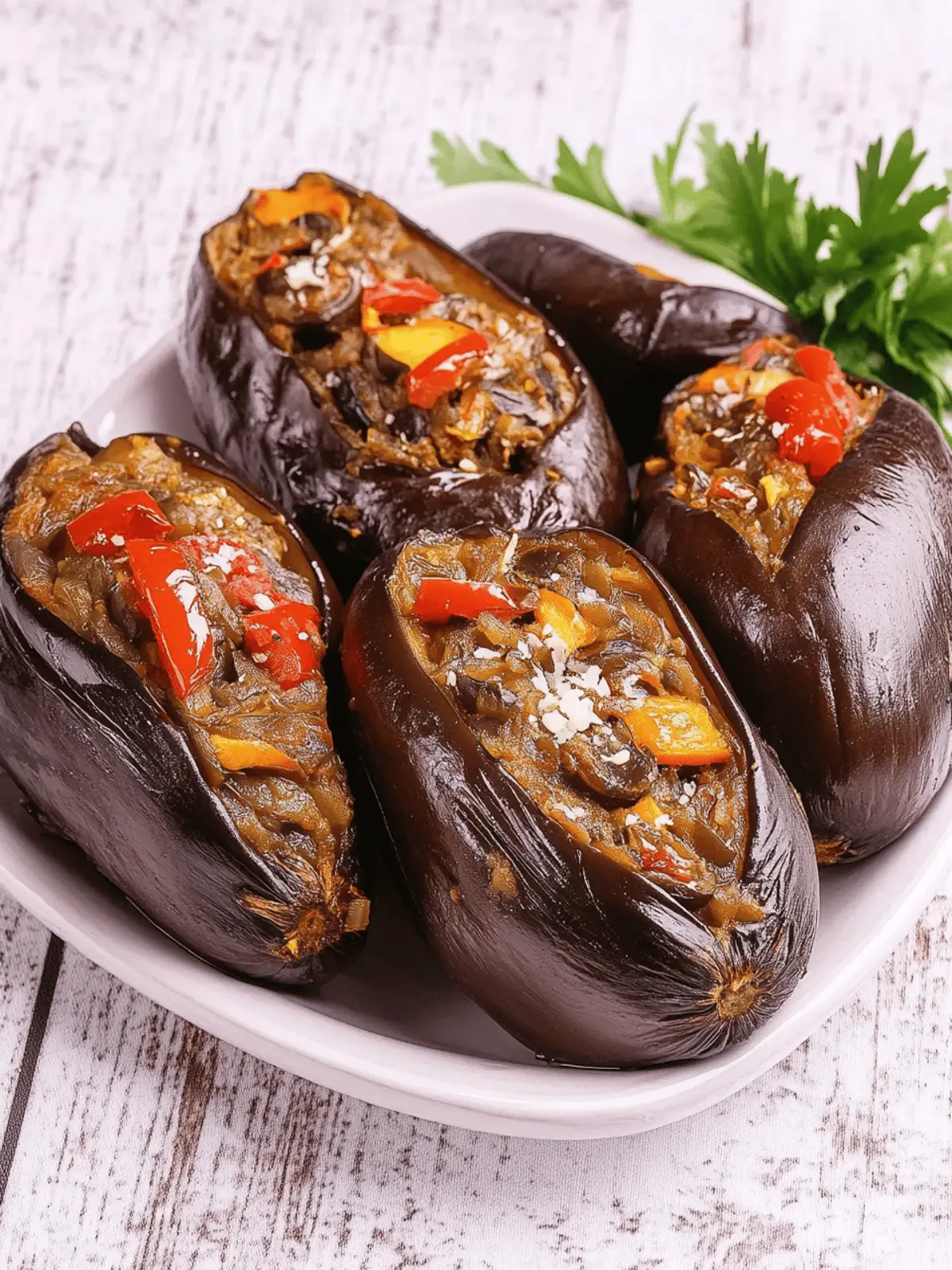
Irresistible Lebanese Makdous: Your New Favorite Eggplant Treat
Ingredients
Equipment
Method
- Bring a large pot of water to a boil. Trim the stems from the baby eggplants, but keep them whole. Blanch the eggplants in boiling water for 5-7 minutes until they're slightly softened, then drain and let cool.
- Once the eggplants are cool enough to handle, carefully make a slit lengthwise in each one, stopping about 3/4 down. Sprinkle salt inside the slits and all over the eggplants. Place them in a colander, cover with a plate, and add some weight to help extract moisture. Let them drain for 24 hours.
- In a medium bowl, combine the finely chopped walnuts, minced garlic, red pepper flakes, and finely chopped red bell pepper. If you're using cumin and coriander, add them now. Mix in 2 tablespoons of olive oil to help bind the mixture and season with salt to taste.
- Rinse the eggplants under water to remove excess salt and pat them dry with paper towels. Gently open each eggplant and stuff with the walnut mixture, packing it in firmly.
- In a sterilized jar, layer the stuffed eggplants, pressing them down gently to pack snugly. Pour enough olive oil into the jar to cover the eggplants completely.
- Seal the jar tightly and place it in a cool, dark place. Allow the makdous to pickle for at least 5-7 days; for the richest flavor, let them cure for two weeks.
- When ready, remove the makdous from the jar. Drizzle with extra olive oil if desired and serve them as part of a mezze spread.

